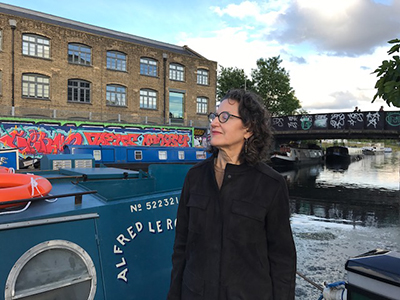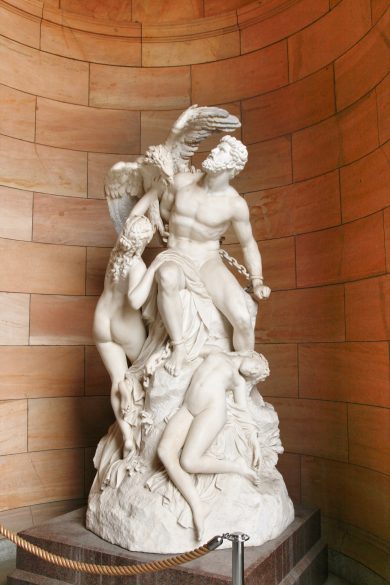Memory Series: Karen Bassi

Karen Bassi is Professor of Literature and Classics at UC Santa Cruz. She is the former Director of the Classical Studies Program, housed in the Humanities Division, which supports the study of ancient languages and interdisciplinary approaches to the field. Bassi’s own work examines how ancient authors thought and wrote about their relationship to the past and future—and also how the idea of the past itself is constructed and maintained as an object of study. Bassi’s contribution to our 2021 Memory Series speaks to the complexities of this conjuncture. Through it, her piece invites us to reflect on how memory is “historically entwined with human suffering and precarity, with the imagining of mental structures, with technological innovation, and with relations of knowledge and power.”
Memory: A Brief History
Human memory is selective, incomplete and fallible. It is also (if subjectively) quantifiable; some things are more memorable than others. Memory is also a key heuristic in the human sciences, dedicated to understanding the means by which humans come to know their place in the world. What is sometimes called “cultural memory” in humanistic research invites reflection on its relationship to individual memory, i.e., memories accumulated over a lifetime. Memories are also the putative bases for validating and legitimizing historical and autobiographical works, where these genres occupy the poles of a continuum from the collective to the individual. Collective and individual memories overlap most acutely in response to national traumas or a global pandemic, i.e., to what we might want to forget. But what are the mechanisms by which we can make ourselves remember or forget something? What justifies doing so? And what is the role of memory in predicting and giving meaning to the future?
The notion that memory and its loss define and mediate our sense of time is embedded in the history of memory in the West.
The notion that memory and its loss define and mediate our sense of time is embedded in the history of memory in the West. In Hesiod’s Theogony (8th c. BCE) Mnemosyne (Memory) is a divinity and the mother of the nine Muses. In the proto-literate culture of Homer’s Iliad and Odyssey, memory is the vehicle of the poet’s orally composed art, aided by a regular metrical pattern and the repetition of lines and phrases. A notable episode takes place at the royal court of the Phaeacians in Book 8 of the Odyssey. There the blind poet Demodocus causes Odysseus to groan and weep by singing about the “beginning of the calamity” that was the Trojan War (pêmatos archê, Odyssey 8.83ff.). The episode establishes a relationship between the poet’s memory of past events and the memory of the man who had lived them, or between Mnemosyne as divine inspiration and mnêmê as a human faculty. It also establishes memory as a source of human suffering.
In the 6th c. BCE, Simonides of Ceos (c.556-c.468 BCE) is credited with discovering the art of mnemonics as a technical skill. According to Cicero (106-43 B.C.E.), Simonides had just exited a banquet hall when the roof of the building suddenly collapsed, crushing the diners inside. He was able to identify their dead bodies by remembering where each person had been sitting. What came to be known as the method of loci was used by orators who memorized their speeches for future delivery by associating each section with an object arranged in an architectural space; this came to be referred to as a “memory palace.” As Cicero puts it, Simonides discovered that “Order brings the greatest light to memory” (de Oratore 2.86). In the anecdote, the spatial arrangement of visual images is the vehicle of memory. But it is also about sudden death and Simonides’ own narrow escape.

In Aeschylus’ tragedy Prometheus Bound (472 BCE), the Titan Prometheus enumerates his gifts to humans, gifts that enabled them to transcend their previously primitive existence. These include first of all “numbers, preeminent among skills, and combinations of letters, memory of everything, the creative mother of the Muses” (lines 460–61). By the fifth-century BCE, a time of increased literacy in Athens, memory has become aligned with alphabetic writing (letters or grammata). This is a decisive moment in the history of memory in the West. In Prometheus’ speech, writing is equated with the “memory (mnêmê) of everything.” Memory has not lost its mythological genealogy; it is still “the mother of the Muses.” But this divine attribution has given way to human invention. The Prometheus Bound focuses on the horrific tortures that Prometheus is made to endure for helping humans: he is chained to a rock where an eagle will eat his liver for eternity. What the play “remembers” most vividly – preserved in its grammata – is the Titan’s unending suffering.
In the fourth century, Plato strips the epic and tragic poets of their privileged positions as the arbiters of memory. In the Ion, Socrates grants that the epic poet is divinely inspired. But this is precisely why he has no true knowledge of the things about which he sings. In the Republic, Socrates notoriously ejects the tragic poet from Kallipolis, the beautiful city, because his works are far removed from the truth. In the competition between poetry and philosophy, memory reaches an impasse. This is perhaps most evident in Plato’s Phaedrus (274b-277a), in which Socrates claims that alphabetic writing – far from preserving the “memory of everything” – fosters forgetting. Socrates tells a story about the god Theuth who, like an Egyptian Prometheus, discovered “number and calculation, geometry and astronomy, as well as the games of draughts and dice, and above all else, writing” (274d). In Socrates’ account, Theuth extolls the virtues of these arts to Thamus, the king of Egypt. But the king disputes the claim that writing enhances memory (275a-b):
[Writing] will produce forgetting (lêthê) in the minds of those who learn to use it, because they will neglect their memory. Their trust in writing is produced by characters which are outside (exothên) of themselves and are not inside (endothên) those who call things to mind by themselves. You have invented a drug (pharmakon) not of memory mnêmê), but of reminding (hupomnêsis).
According to this spatial scheme, memory (mnêmê) is inside (endothên) the mind while reminding (hupomnêsis) is outside (exothên) the mind. Writing fosters the latter as a kind of lower-order memory. The passage assumes that memories are made up of lived perceptions and experiences that are – in principle — prior to being “inside” an individual’s mind. The problem, says Socrates, is that unlike and inferior to these perceptions and experiences, writing simply repeats itself. It “always says the same thing” and therefore has no power to “protect or help itself” (275d-e). For Plato, live conversation is the only means of getting to the truth. At stake are the nature and value of philosophical inquiry, complicated by the fact that Plato’s works are themselves written texts.
As these examples illustrate, memory is not a neutral concept in the West. Nor is it easily defined. It is historically entwined with human suffering and precarity, with the imagining of mental structures, with technological innovation, and with relations of knowledge and power. This history extends into our own times, exemplified by developments in the nineteenth and twentieth centuries. Memory plays a critical role in the advent of archaeology as a scientific discipline and of photography as a documentary form. It activates and justifies the founding of museums and archives as repositories of data about formerly living humans. Psychoanalysis, the most influential account of the human psyche in the twentieth century, constitutes a singular contribution to this extended history. Freud often used archaeology as a topographical metaphor for psychic life in which “buried memories” of traumatic events are uncovered to reveal the truth about a patient’s present condition; his key example were the recent excavations of the ruins of Pompeii. These metaphors reflect Freud’s interest in Mediterranean antiquity generally and recall the spatial imaginaries of Simonides and Socrates. Freud’s universalist claims have to be acknowledged. But these are themselves familiar from the history of memory, beginning with its divine genealogy and including its anecdotal and philosophical forms. What psychoanalysis adds is a deeper understanding of the relationship of memory to “what has come to count as history,” in Joan Scott’s words (2018.98). Memory is not the source of facts about the past, but a means of disavowing our role in its (the past’s) construction. In Vered Lev Kenaan’s succinct formulation, “For Freud, the testimony of memory does not entail facts but renders the absence of the past irrevocable” (2019.29). Psychoanalysis demonstrates that memory is what compensates for this absence. In doing so, it confronts the role of memory in refusing or accepting ethical and moral responsibility in the present and for the future.
The “order” that museums have historically imposed upon their objects assumes a universal and normative understanding of memory and elides its links to nationalism, colonialism, and imperialism.
Named after the daughters of Memory, the modern museum institutionalizes the relation of history to memory together with the obligation of confronting this responsibility. In 2019, I co-directed an NEH Summer Institute in Washington D.C. titled Museums: Humanities in the Public Sphere. The Institute brought together scholars from around the country to explore the current state of museum studies in the US. Visits to the major Smithsonian museums and lectures by visiting scholars focused on the extractive, racist, and often violent tactics employed by museums in the name of “preserving” the past. We also visited museums that expose and interrogate these tactics, represented by the National Museum of African American History and Culture. The latter challenge Cicero’s assertion that “Order brings the greatest light to memory.” The “order” that museums have historically imposed upon their objects assumes a universal and normative understanding of memory and elides its links to nationalism, colonialism, and imperialism. Within the long history of memory, it forgets that Simonides’ “memory palace” was built on death and ruins.
References
Armstrong, Richard. “Contrapuntal Affiliations: Edward Said and Freud’s Moses.” American Imago 62 (2005): 235-57.
Armstrong, Richard H. “Last Words: Said, Freud, and Traveling Theory.” Alif: Journal of Comparative Poetics 25 (2005): 120-48.
Hutton, Patrick H. “The Art of Memory Reconceived: From Rhetoric to Psychoanalysis.” Journal of the History of Ideas 48 (1987): 371-92.
Kenaan, Vered Lev. The Ancient Unconscious, Psychoanalysis and Classical Texts. Oxford: Oxford University Press, 2019.
“Memory: A Brief History” is part of The Humanities Institute’s 2021 Memory Series. This series features contributions from a range of faculty and emeriti in the Humanities community at UC Santa Cruz – each of whom highlight connections between memory and their work or meditate on memory’s relevance in our current moment. Throughout Spring quarter, be sure to look for these amazing essays in our weekly newsletter!
